HSBC 2002 Annual Report Download - page 307
Download and view the complete annual report
Please find page 307 of the 2002 HSBC annual report below. You can navigate through the pages in the report by either clicking on the pages listed below, or by using the keyword search tool below to find specific information within the annual report.-
 1
1 -
 2
2 -
 3
3 -
 4
4 -
 5
5 -
 6
6 -
 7
7 -
 8
8 -
 9
9 -
 10
10 -
 11
11 -
 12
12 -
 13
13 -
 14
14 -
 15
15 -
 16
16 -
 17
17 -
 18
18 -
 19
19 -
 20
20 -
 21
21 -
 22
22 -
 23
23 -
 24
24 -
 25
25 -
 26
26 -
 27
27 -
 28
28 -
 29
29 -
 30
30 -
 31
31 -
 32
32 -
 33
33 -
 34
34 -
 35
35 -
 36
36 -
 37
37 -
 38
38 -
 39
39 -
 40
40 -
 41
41 -
 42
42 -
 43
43 -
 44
44 -
 45
45 -
 46
46 -
 47
47 -
 48
48 -
 49
49 -
 50
50 -
 51
51 -
 52
52 -
 53
53 -
 54
54 -
 55
55 -
 56
56 -
 57
57 -
 58
58 -
 59
59 -
 60
60 -
 61
61 -
 62
62 -
 63
63 -
 64
64 -
 65
65 -
 66
66 -
 67
67 -
 68
68 -
 69
69 -
 70
70 -
 71
71 -
 72
72 -
 73
73 -
 74
74 -
 75
75 -
 76
76 -
 77
77 -
 78
78 -
 79
79 -
 80
80 -
 81
81 -
 82
82 -
 83
83 -
 84
84 -
 85
85 -
 86
86 -
 87
87 -
 88
88 -
 89
89 -
 90
90 -
 91
91 -
 92
92 -
 93
93 -
 94
94 -
 95
95 -
 96
96 -
 97
97 -
 98
98 -
 99
99 -
 100
100 -
 101
101 -
 102
102 -
 103
103 -
 104
104 -
 105
105 -
 106
106 -
 107
107 -
 108
108 -
 109
109 -
 110
110 -
 111
111 -
 112
112 -
 113
113 -
 114
114 -
 115
115 -
 116
116 -
 117
117 -
 118
118 -
 119
119 -
 120
120 -
 121
121 -
 122
122 -
 123
123 -
 124
124 -
 125
125 -
 126
126 -
 127
127 -
 128
128 -
 129
129 -
 130
130 -
 131
131 -
 132
132 -
 133
133 -
 134
134 -
 135
135 -
 136
136 -
 137
137 -
 138
138 -
 139
139 -
 140
140 -
 141
141 -
 142
142 -
 143
143 -
 144
144 -
 145
145 -
 146
146 -
 147
147 -
 148
148 -
 149
149 -
 150
150 -
 151
151 -
 152
152 -
 153
153 -
 154
154 -
 155
155 -
 156
156 -
 157
157 -
 158
158 -
 159
159 -
 160
160 -
 161
161 -
 162
162 -
 163
163 -
 164
164 -
 165
165 -
 166
166 -
 167
167 -
 168
168 -
 169
169 -
 170
170 -
 171
171 -
 172
172 -
 173
173 -
 174
174 -
 175
175 -
 176
176 -
 177
177 -
 178
178 -
 179
179 -
 180
180 -
 181
181 -
 182
182 -
 183
183 -
 184
184 -
 185
185 -
 186
186 -
 187
187 -
 188
188 -
 189
189 -
 190
190 -
 191
191 -
 192
192 -
 193
193 -
 194
194 -
 195
195 -
 196
196 -
 197
197 -
 198
198 -
 199
199 -
 200
200 -
 201
201 -
 202
202 -
 203
203 -
 204
204 -
 205
205 -
 206
206 -
 207
207 -
 208
208 -
 209
209 -
 210
210 -
 211
211 -
 212
212 -
 213
213 -
 214
214 -
 215
215 -
 216
216 -
 217
217 -
 218
218 -
 219
219 -
 220
220 -
 221
221 -
 222
222 -
 223
223 -
 224
224 -
 225
225 -
 226
226 -
 227
227 -
 228
228 -
 229
229 -
 230
230 -
 231
231 -
 232
232 -
 233
233 -
 234
234 -
 235
235 -
 236
236 -
 237
237 -
 238
238 -
 239
239 -
 240
240 -
 241
241 -
 242
242 -
 243
243 -
 244
244 -
 245
245 -
 246
246 -
 247
247 -
 248
248 -
 249
249 -
 250
250 -
 251
251 -
 252
252 -
 253
253 -
 254
254 -
 255
255 -
 256
256 -
 257
257 -
 258
258 -
 259
259 -
 260
260 -
 261
261 -
 262
262 -
 263
263 -
 264
264 -
 265
265 -
 266
266 -
 267
267 -
 268
268 -
 269
269 -
 270
270 -
 271
271 -
 272
272 -
 273
273 -
 274
274 -
 275
275 -
 276
276 -
 277
277 -
 278
278 -
 279
279 -
 280
280 -
 281
281 -
 282
282 -
 283
283 -
 284
284 -
 285
285 -
 286
286 -
 287
287 -
 288
288 -
 289
289 -
 290
290 -
 291
291 -
 292
292 -
 293
293 -
 294
294 -
 295
295 -
 296
296 -
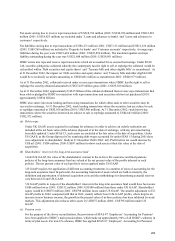 297
297 -
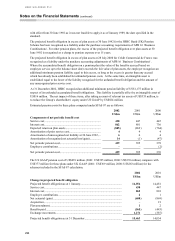 298
298 -
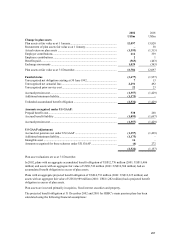 299
299 -
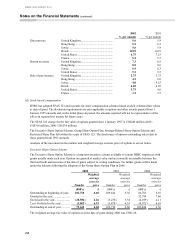 300
300 -
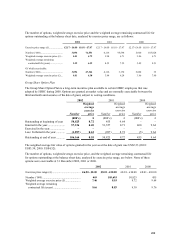 301
301 -
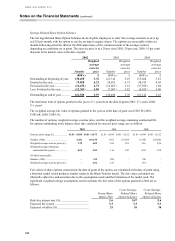 302
302 -
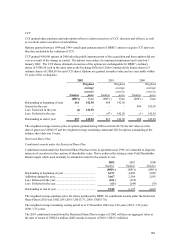 303
303 -
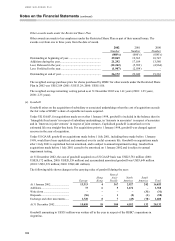 304
304 -
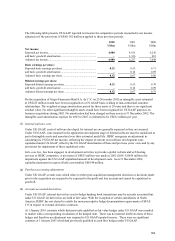 305
305 -
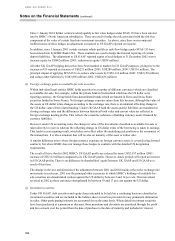 306
306 -
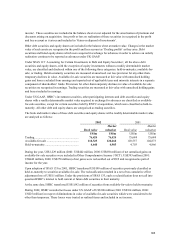 307
307 -
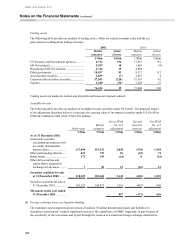 308
308 -
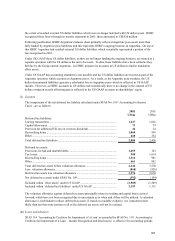 309
309 -
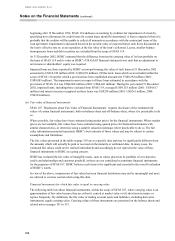 310
310 -
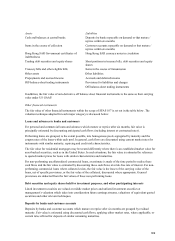 311
311 -
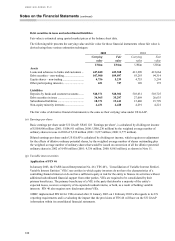 312
312 -
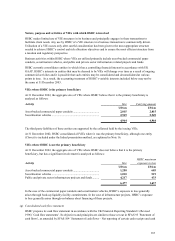 313
313 -
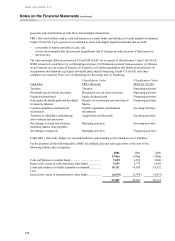 314
314 -
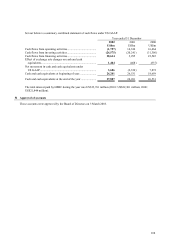 315
315 -
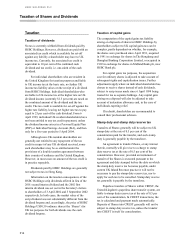 316
316 -
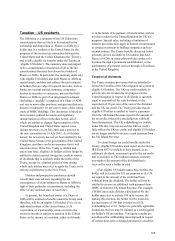 317
317 -
 318
318 -
 319
319 -
 320
320 -
 321
321 -
 322
322 -
 323
323 -
 324
324 -
 325
325 -
 326
326 -
 327
327 -
 328
328 -
 329
329
 |
 |

305
income’ . These securities are included in the balance sheet at cost adjusted for the amortisation of premium and
discounts arising on acquisition. Any profit or loss on realisation of these securities is recognised in the profit
and loss account as it arises and included in ‘Gains on disposal of investments’ .
Other debt securities and equity shares are included in the balance sheet at market value. Changes in the market
value of such assets are recognised in the profit and loss account as ‘Dealing profits’ as they arise. Debt
securities and listed equity shares which were acquired in exchange for advances in order to achieve an orderly
realisation continue to be reported as advances under UK GAAP.
Under SFAS 115 ‘Accounting for Certain Investments in Debt and Equity Securities’ , all the above debt
securities and equity shares, with the exception of equity investments without a readily determinable market
value, are classified and disclosed within one of the following three categories: held-to-maturity; available-for-
sale; or trading. Held-to-maturity securities are measured at amortised cost less provision for any other-than-
temporary declines in value. Available-for-sale securities are measured at fair value with unrealised holding
gains and losses excluded from earnings and reported net of applicable taxes and minority interests in a separate
component of shareholders’ funds. Provisions for other-than-temporary declines in value of available-for-sale
securities are recognised in earnings. Trading securities are measured at fair value with unrealised holding gains
and losses included in earnings.
Under US GAAP, HSBC’ s investment securities, other participating interests and debt securities and equity
shares with a readily determinable market value acquired in exchange for advances are classified as available-
for-sale securities, except for certain securities held by RNYC at acquisition, which were classified as held-to-
maturity. All other debt and equity shares are categorised as trading securities.
The book and market values of these debt securities and equity shares with a readily determinable market value
are analysed as follows:
2002 2001
Book value Marke
t
valuation Book value
M
arke
t
valuation
US$m US$m US$m US$m
Trading............................................................. 76,424 76,424 75,684 75,684
Available-for-sale ............................................ 118,325 120,468 103,557 104,873
Held-to-maturity .............................................. 4,648 4,905 4,703 4,866
During the year, US$1,229 million (2001: US$442 million, 2000: US$850 million) of net unrealised gains on
available-for-sale securities were included in Other Comprehensive Income (‘OCI’ ). US$393 million (2001:
US$442 million, 2000: US$270 million) of net gains were reclassified out of OCI and recognised as part of
income for the year.
Upon adoption of SFAS 133 in 2001, HSBC transferred US$190 million of securities previously classified as
held-to-maturity to securities available-for-sale. The reclassification resulted in a net of tax cumulative effect
adjustment loss of US$11 million. Under the provisions of SFAS 133, such a reclassification does not call into
question HSBC’ s interest to hold current or future debt securities to their maturity.
At the same date, HSBC transferred US$1,042 million of securities from available-for-sale to held-to-maturity.
During 2002, HSBC recorded net losses under US GAAP of US$308 million (2001 US$104 million; 2000:
US$25 million) in respect of diminutions in value of available-for-sale securities which were considered to be
other than temporary. These losses were treated as realised items and included in net income.
